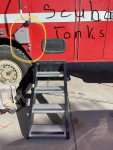charlieaarons
Explorer
MAN has an option on their medium and HD trucks of hydraulic driven front drive in addition to conventional RWD. Saves the weight of transfer case, front axle. No low range of course. Mainly for occasional 4wd needs like a muddy construction site.
I think one Unicat customer has chosen it for a chassis. Might be good for the archetypal RV “stuck on wet grass”, along with electric FWD. Of course a locking rear diff also helps a lot.
I think one Unicat customer has chosen it for a chassis. Might be good for the archetypal RV “stuck on wet grass”, along with electric FWD. Of course a locking rear diff also helps a lot.

